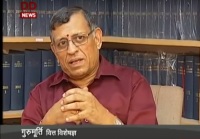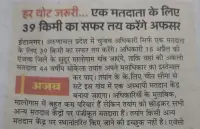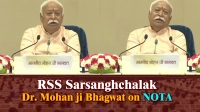Sri Swaminathan Gurumurthy, well-known Chartered Accountant, Economics Thinker, Philosopher and political commentator, has been a long time crusader against black money. He spoke to Doordarshan TV channel (DD News) about the need for Demonetization and how it affects the Indian economy.

Interview Excerpts:
1. Demonetization Is Long Overdue & Inevitable
* Demonetization is long overdue and is inevitable for longevity of economy and sustained growth. This is a huge investment by Government as well as the Economy, as a preparation to reach higher levels of economic growth.
* This move could not have been made more comfortable and there cannot be adequate preparation for Demonetization of this scale. Secrecy is necessary for such a massive operation or else everyone would have guessed as to why new notes are coming into market. Only a strong Prime Minister could have taken such bold decision.
* We must congratulate the people of the country for showing extra ordinary patience by standing in the long queues (with no slogans or protests). The counterfeit currency must go.
* Out of the total circulation of 16.6 lac crores currency, 14.5 lac crores currency (about 87 per cent of 500, 1000 notes) is with the public. How much of it finances genuine economy and how much of it finances illicit economy is not clear. Over and above that is the fake currency in circulation that is not counted in the overall figure of 16.6 lac Crores that directly affects security of India. For instance, 3 per cent of the total amount deposited in the banking system since the Demonetization began, was in Jammu Kashmir bank. The extremists had given a threat not to go and deposit the money – they have queued up to deposit the money! And there has been sudden drop in the unrest in Jammu Kashmir.
2. Reasons that led to excessive “Cash Economy”:
* “Wealth effect” and “Real Estate” have led to Cash economy
* As the banking habits pick up, the “Cash economy” should have gone down, but has increased. The growth of cash economy in proportion to the gross domestic product (GDP) – was less than 10 per percent until 2001, now it is almost 12 per cent of GDP. This has also been facilitated by the rise in the proportion of high denomination currency (as high as 87 per cent) and that has led to illicit money.
* Studies show that 50% of Indian economy is Cash-economy. Cash-economy does not mean it is illicit economy. It is actually genuine Cash-economy. 90% of the employment is attributed to economy driven by largely cash or ‘unorganized‘ sector which is largely funded by cash. It is very complex situation. This has resulted in huge cash hoardings and transactions between cash and gold, transaction between property and gold, which has resulted in unusual amount of hoarding of gold, investment in land and land prices beyond reach of the common man.
* This has led to distortions in the economy, especially in Real Estate, Gold prices, usurious lending to small and micro businesses. This is also partly a failure of the banking system. So, it had distorted the economy in the last 10-12 years, because of what is called the “Wealth effect”. The high rise of the stock market also contributed to all this. This situation had to be handled. Only a strong prime minister could have taken this decision.
* Cash economy has moved deep into Indian economy. Cash does not create illicit opportunity – Illicit opportunity creates Cash.
3. On Terror Funding
* Terror funding by normal currency is one and Terror funding by counterfeit currency is another. For example, Naxalite funding is through normal currency in the form of ‘hafta‘ collections. About Rs 50,000 to Rs 60,000 crores of the extremist funding is in the Naxal-affected area in the cash form, mostly in 500 and 1000 denominations. Naxal funding is designed for Cash economy and not for bank economy. Left extremism will receive a very, very serious setback because of Demonetization.
4. Positive Economic Consequences
* According to an estimate by State Bank of India, out of Rs 12 lac crores in the cash economy, Rs 3 lac crores may never come back into the system (owing to large scale bribes, kickbacks) and will never reach the banking coffers at all. So, there will be the monetary surplus in the Reserve Bank of India (RBI).
* Out of the Rs 12 lac crores that comes in, the government should get substantial tax revenue of about Rs 2 lac crores. This should have far-reaching consequences on the Indian growth story.
* Government should get an estimate of 5 lac Crores as revenue surplus. When it comes into the banking system, this 5 lac Crores may become 20 lac Crores because of the “fractional reserves basis”, this Rs 5 lac crores can become Rs 20 lac crores. (Reserve + Investment of 25 per cent; the rest 75 per cent given as loans that goes back into the system, say a year from now). Thus banking system transforms into multiple of 3 or 4.
Illustrative Example: Let us assume Rs 100 is deposited in a bank. About one quarter of the amount will be invested in government bonds and reserves. The remaining 75 per cent will be available for lending. This 75 per cent gets into the banking system. My estimate is that at a minimum, the banking system multiplies the money in the system by three or four times. This money creation by banks will increase prosperity. The black or the cash economy therefore is inefficient in using money this way.
* Reduction in Interest rates: There will be genuine rise in Demand (due to increased consumer spending) leading to genuine rise in GDP numbers. There will be all round reduction in interest rates for business and moderation of interest rates (necessary for our growth in the economy). The lower interest rate is advantage to SME (Small, Medium Enterprises), who may not have sources from abroad unlike big industries or MNCs (who have access to foreign funds at a very lower interest rates / international rates). The reduction in interest rates will be very good for our economy.
* Positive impact on Fiscal situation: Government’s Tax collections may increase, which leads to strengthening of Fiscal situation (due to Rs. 2.5 lac “soft landing rule” – a boon for middle class having savings in the name of family members; had it not been there, they would have had to pay tax on their savings for last 10 years).
* Land prices expected to moderate: Because of the withdrawal of Cash from the Real-Estate economy, the land prices are expected to moderate and can see a drop of around 30-40 per cent in the land prices, particularly in urban areas. This will increase the affordability of housing; most people are not able to afford houses because of high land prices. Housing is important economic activity that will pick up.
* Construction prices are dependent on commodities; land prices are dependent on the amount of money that chases land (as land supply is limited). Commodities have Supply-Demand adjustments.
5. The Challenges Ahead:
* Gold & Cash exchangeability is very important of promoting both. Now Cash being cut, Gold-economy will receive a serious setback. Government need to go for some Gold Reforms. Government should have persuasive policy towards Gold spend and not the way it happens in other parts of the world (of fighting against Gold consumption).
* Generation of “illicit cash” will come down rapidly and it will take long time to generate Cash of this kind again, added to Government’s special efforts to curb such cash. Now, such economy has to be replaced with proportionate genuine cash. As per Economic Census 2014 (58 million “non-farming enterprises” have capital of 12 lac Crore which provide employment to 128 million people, was intended to be financed by MUDRA scheme, “Micro Units Development and Refinance Agency Bank under “Pradhan Mantri Mudra Bank Loan Scheme”).
* The Government has to take special measures to fund Cash-led sectors (Agriculture, SMEs and small traders. MUDRA Law should be passed immediately and this sector must be funded through non-banking institutions and private financiers. They should be registered through banking system and their receivables and advances must be refinanced by the banking system. This Dr.Manmohan Singh did in 1993 when commercial vehicles sector was being funded by the banking and non-banking system for the new vehicles. Non-banking system was financing only the second hand or third hand vehicles. So, Manmohan Singh said, some Rs.300 crores must be given for non-banking finance companies so that they can finance even second and third hand vehicles that saw a huge growth in the commercial vehicles sector. The same move can be adopted for all businesses which are being funded by non-banking financial companies and private financiers and the local bank’s branches can register the local non-banking finance companies and the local financiers and advance money’s is their receivables this is the Indian way of helicopter dropping money, which is very necessary in the next one month. This will have a huge impact on providing liquidity, which otherwise banking sector cannot provide directly.
* After calming and correcting the Demand side, the challenge is, how to infuse liquidity on the Production sector (Supply side) : by refinancing/ by putting money into the Production sector through non-banking financial institutions and asking Public Sector, Government and BSE 500 companies to pay salaries in cash (atleast 30 per cent in cash).
* More measures such as “Jan Dhan Yojana” have to be used for increasing greater awareness, especially in rural India.
* Cashless economy is a dream; Minimum Cash economy is practical.
Demonetization as the foundation, Government has to address “jobless growth” for a better Job creation and rapid growth for next 10 years.
6. On Election Funding:
* Consensus required by all the political parties on Election funding; this cannot be done merely by ruling party. Political funding has to become transparent through “State funding of elections” has to be pursed vigorously. The private funding of elections has to stop. There has to be an “Election Tax” at the State level, Central level and Municipal level. Classification of National and Regional parties has to change depending on the capacity of the parties. Center and State elections have to align.
Watch the full interview below:





Leave a comment